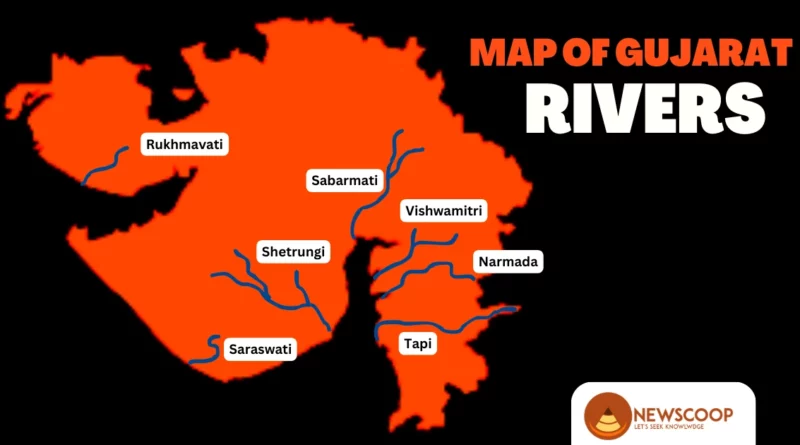Rivers of Gujarat with Map: Largest & Smallest
Gujarat, located on the western coast of India, is a land blessed with natural beauty and rich cultural heritage. One of the defining features of this vibrant state is its intricate network of rivers that flow through its diverse landscapes. These rivers have played a significant role in shaping the history, ecology, and economy of Gujarat.
Join us on a journey as we explore the rivers of Gujarat on Map, the lifelines that have nurtured this region for centuries.
| Sabarmati River | Narmada River |
| Tapi River | Mahi River |
| Machchhu River | Hiran River |
| Banas River | Kim River |
| Rupen River | Aji River |
Rivers of Gujarat
Gujarat’s rivers play a significant role in the state’s ecosystem and economy. With a coastline spanning over 1,600 kilometers along the Arabian Sea, the rivers bring freshwater into the coastal regions, maintaining a delicate balance of marine and terrestrial ecosystems. The major river basins, including Sabarmati, Narmada, Tapi, and Mahi, provide essential water resources for agriculture, supporting the state’s agricultural economy.
These rivers originate from diverse sources such as the Aravalli and Satpura ranges, meandering through Gujarat’s landscapes, and enriching the lands they pass through. They are not only lifelines but also vital habitats for a wide array of plant and animal species.
Largest and longest River in Gujarat
The Narmada River is the longest and largest river in Gujarat. It originates from the Amarkantak Plateau in Madhya Pradesh and flows through central Gujarat, covering a total distance of approximately 1,312 kilometers before emptying into the Arabian Sea. The Narmada River holds immense religious and cultural significance and is often referred to as the “Lifeline of Gujarat.”
Smallest River in Gujarat
The Aji River is the smallest river in Gujarat. It is important for providing water to the Rajkot district. It starts in the hills of Lodhika and Sardhar and flows through Rajkot before reaching the Arabian Sea.
Gujarat Rivers on Map

Major Rivers of Gujarat
Here is a list of major rivers in Gujarat:
- Sabarmati River
- Narmada River
- Tapi River
- Mahi River
- Machchhu River
- Hiran River
- Banas River
- Kim River
- Rupen River
- Aji River
- Vishwamitri River
1. Sabarmati River
The Sabarmati River is a significant river in Gujarat. It originates in the Aravalli Range and flows through major cities like Ahmedabad and Gandhinagar before merging with the Arabian Sea. The Sabarmati River has historical and cultural importance in Gujarat, and it played a crucial role in the Indian independence movement led by Mahatma Gandhi. The river is known for the Sabarmati Riverfront Development Project, which transformed its banks into a vibrant public space.
2. Narmada River

The Narmada River, one of India’s longest rivers, holds great significance in the heart of Gujarat. Originating from the Amarkantak Plateau in Madhya Pradesh, it gracefully meanders through Madhya Pradesh, Maharashtra, and Gujarat before merging with the Arabian Sea. Revered as a sacred river, the Narmada is believed to cleanse the sins of those who bathe in its waters. It serves as a lifeline for Gujarat, providing water for irrigation, drinking, and industrial purposes.
Tapi River
The Tapi River, also referred to as the Tapti River, is a significant waterway flowing through central India. It originates in the eastern region of Madhya Pradesh and gracefully traverses Maharashtra and Gujarat before merging with the Arabian Sea. Along its journey, the Tapi River passes through notable cities like Surat, enchanting onlookers with its picturesque landscapes.
Mahi River

The Mahi River, flowing through western India, originates in the Vindhya Range of Madhya Pradesh with a total length of approximately 580 kilometers. It spans across Rajasthan before entering Gujarat. The river serves as a crucial water source for irrigation, drinking water, and industrial purposes. It supports diverse ecosystems and is home to various species of flora and fauna. With its picturesque landscapes, including the scenic Aravalli Range and fertile plains of Gujarat, the Mahi River attracts tourists.
Machchhu River
The Machchhu River, originating from the Madla highlands, is a western river in India. It stretches for 130 kilometers and covers a basin area of 2,515 square kilometers. The river gained attention due to a tragic incident in 1979 when the breach of the Machchhu dam caused severe devastation in Morbi town, resulting in loss of life. Despite being relatively less known, the Machchhu River plays a significant role in the lives of the local residents. The surrounding region has been developed as a popular tourist spot, offering visitors the chance to enjoy quality time with their loved ones.
Hiran River
The Hiran River, originating from the Sasa hills of the Gir forest, is part of India’s collection of western rivers. The river’s drainage basin extends up to a maximum length of 40 kilometers. The presence of vibrant wildlife enhances the charm of the river’s surroundings. Lush greenery adorns the banks, with thriving trees, and the area is inhabited by a diverse range of aquatic plants and animals. Birdwatchers will delight in the abundance of unique bird species found here. The river not only supports the ecosystem but also sustains human settlements in the area.
Banas River
The Banas River is a prominent river in Gujarat, India. Originating from the Kumbhalgarh hills in Rajasthan, it flows through several districts of Gujarat, including Sabarkantha and Mehsana. The river has a total length of approximately 512 kilometers. Additionally, the Banas River holds cultural and historical importance, with several ancient temples and archaeological sites situated along its banks.
Kim River
The Kim River, originating from the scenic hills of Saputara, boasts a drainage basin with a maximum length of 107 kilometers, making it one of the significant rivers in Gujarat. It flows through the villages of Ilav and Elaw, with Tukki and Ghanta serving as their primary streams. The river’s banks have been explored, revealing fascinating findings of the ancient Harappan civilization extending up to 500 kilometers. However, the Kim River has suffered from severe pollution. Recognizing its importance, the Gujarat government is undertaking substantial efforts to prevent pollution and protect this valuable waterway.
Rupen River
The Rupen River, originating from the Taranga hills in western Gujarat, has its own unique characteristic as it does not flow into the ocean but instead dries up in the Rann of Kutch. With a drainage basin spanning a maximum length of 156 kilometers and a catchment area of 2,500 square kilometers, the river is fed by right bank tributaries such as Pushpavati and Khari rivers, while the left bank is formed by the Khari river. The right side of the river flows with more intensity compared to the left side.
Aji River
The Aji River, the smallest river in Gujarat, serves as the primary water source for Rajkot district. Stretching for a length of 102 kilometers, it originates from the hills located in Lodhika and Sardhar. Flowing through various parts of Rajkot, the Aji River eventually meets the Arabian Sea.
Vishwamitri River
The Vishwamitri River originates from Pavagadh in the Panchmahal District of Gujarat. It flows predominantly through the western part of Vadodara city. The river is named after the renowned saint Vishwamitra. It receives two tributaries, Dhadhar and Khanpur, before merging with the Gulf of Khambhat. The river’s banks have witnessed human settlements dating back to 1000 B.C., providing evidence of its historical significance and its association with the Stone Age era.
Dams in Gujarat
Gujarat, a state in western India, is blessed with several rivers and the presence of numerous dams that harness their waters for various purposes.
Here are some of the major dams and the rivers associated with them in Gujarat:
- Sardar Sarovar Dam – Narmada River
- Ukai Dam – Tapi River
- Dantiwada Dam – Banas River
- Kadana Dam – Mahi River
- Dharoi Dam – Sabarmati River
- Kamleshwar Dam – Vishwamitri River
- Shetrunji Dam – Shetrunji River
- Panam Dam – Panam River
- Machhu Dam – Machhu River
- Hiran-II Dam – Hiran River
- Wanakbori Dam – Mahi River
- Karjan Dam – Karjan River
- Vishnuprayag Dam – Vishwamitri River
- Sukhi Dam – Sukhi River
- Machundri Dam – Machundri River
These dams are strategically built across these rivers to regulate water flow, store water for irrigation, provide drinking water supply to nearby areas, generate hydroelectric power, and mitigate the risk of floods.
The construction of these dams has been a remarkable feat of engineering, enabling efficient water management and promoting agricultural development in the state. They have helped in transforming arid regions into fertile agricultural lands and have played a vital role in the overall socio-economic growth of Gujarat.
Also Read: Mountain Ranges in India
Conclusion
In conclusion, the rivers of Gujarat play a significant role in the state’s history, ecology, and economy. From the majestic Narmada to the bustling Sabarmati and Tapi, these rivers not only provide water for irrigation and drinking but also support diverse ecosystems and contribute to the region’s biodiversity.
Moreover, they offer picturesque landscapes, and recreational opportunities, and serve as important cultural and historical landmarks. Exploring the rivers of Gujarat unveils the natural beauty and richness of the state, making it a captivating destination for tourists and a lifeline for the local communities.
Thank you!
Which is the largest River in Gujarat?
The largest river in Gujarat, India, is the Narmada River. It is one of the most significant rivers in the region, originating in the Amarkantak hills of Madhya Pradesh and flowing through Gujarat before emptying into the Arabian Sea.
Which is the Smallest River in Gujarat?
The Aji River, indeed, is considered one of the smallest rivers in the state of Gujarat, India. It originates near the city of Rajkot and flows through the region before eventually joining the Dhrafad River.

